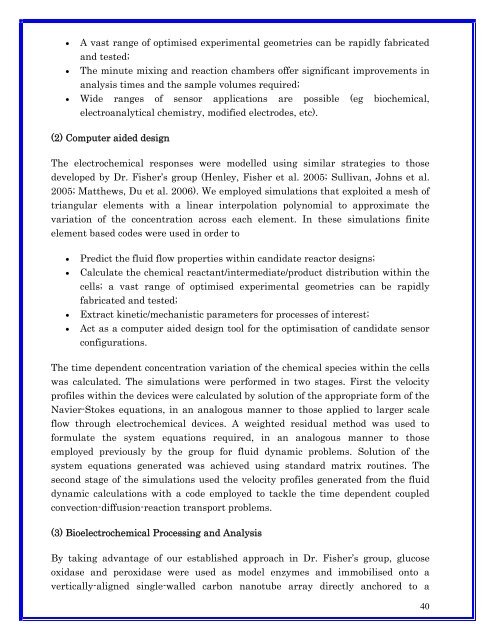Annual Report 2007 - The Australian Nanotechnology Network
Annual Report 2007 - The Australian Nanotechnology Network
Annual Report 2007 - The Australian Nanotechnology Network
You also want an ePaper? Increase the reach of your titles
YUMPU automatically turns print PDFs into web optimized ePapers that Google loves.
• A vast range of optimised experimental geometries can be rapidly fabricated<br />
and tested;<br />
• <strong>The</strong> minute mixing and reaction chambers offer significant improvements in<br />
analysis times and the sample volumes required;<br />
• Wide ranges of sensor applications are possible (eg biochemical,<br />
electroanalytical chemistry, modified electrodes, etc).<br />
(2) Computer aided design<br />
<strong>The</strong> electrochemical responses were modelled using similar strategies to those<br />
developed by Dr. Fisher’s group (Henley, Fisher et al. 2005; Sullivan, Johns et al.<br />
2005; Matthews, Du et al. 2006). We employed simulations that exploited a mesh of<br />
triangular elements with a linear interpolation polynomial to approximate the<br />
variation of the concentration across each element. In these simulations finite<br />
element based codes were used in order to<br />
• Predict the fluid flow properties within candidate reactor designs;<br />
• Calculate the chemical reactant/intermediate/product distribution within the<br />
cells; a vast range of optimised experimental geometries can be rapidly<br />
fabricated and tested;<br />
• Extract kinetic/mechanistic parameters for processes of interest;<br />
• Act as a computer aided design tool for the optimisation of candidate sensor<br />
configurations.<br />
<strong>The</strong> time dependent concentration variation of the chemical species within the cells<br />
was calculated. <strong>The</strong> simulations were performed in two stages. First the velocity<br />
profiles within the devices were calculated by solution of the appropriate form of the<br />
Navier-Stokes equations, in an analogous manner to those applied to larger scale<br />
flow through electrochemical devices. A weighted residual method was used to<br />
formulate the system equations required, in an analogous manner to those<br />
employed previously by the group for fluid dynamic problems. Solution of the<br />
system equations generated was achieved using standard matrix routines. <strong>The</strong><br />
second stage of the simulations used the velocity profiles generated from the fluid<br />
dynamic calculations with a code employed to tackle the time dependent coupled<br />
convection-diffusion-reaction transport problems.<br />
(3) Bioelectrochemical Processing and Analysis<br />
By taking advantage of our established approach in Dr. Fisher’s group, glucose<br />
oxidase and peroxidase were used as model enzymes and immobilised onto a<br />
vertically-aligned single-walled carbon nanotube array directly anchored to a<br />
40



